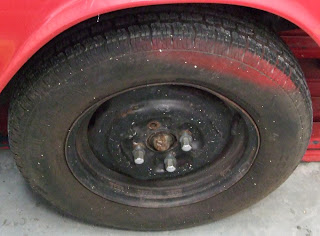 This is what the driver side dash board looked like when I got the car. The wood was questionable at best, all the instruments looked like they could use some work. The dash was removed and stripped of it's instruments and sent to my dad for repair.
This is what the driver side dash board looked like when I got the car. The wood was questionable at best, all the instruments looked like they could use some work. The dash was removed and stripped of it's instruments and sent to my dad for repair. My dad returned to me this very pretty looking dash, nothing like the falling apart thing I sent him. It's solid and even delivered with a protective paper layer.
My dad returned to me this very pretty looking dash, nothing like the falling apart thing I sent him. It's solid and even delivered with a protective paper layer.
The first part cleaned on the dash was this vinyl covered metal edge. The rust was brushed off, vinyl cleaned and conditioned. A light coating of WD-40 was left on the bare metal finish. It was in good condition to start with so the transformation wasn't too extreme. Now on to the Speedometer.

Looking at the speedometer, it doesn't seem too bad. The paint on the outside ring is obviously damaged and was slated for re-painting. The glass was hazy and the jewel for the ignition was floating around somewhere in the thing. I'm not too sure if it even works, as a speedometer from a later/earlier spitfire (chrome outer ring) was sitting in the trunk... Is it a sign from the spitfire gods that I will need it? Who knows...

The Speedometer outer ring was repainted, three times actually, as the paint kept cracking on multiple sprays. The ignition jewel was super-glued in. The glass was cleaned and Rain-Xed and looks simply great. I don't think the trip-odometer works at all. But it looks much better. Now on to the RPM gauge.
 Not as bad off as the speedometer, but still needing the same level of TLC. I have many more pictures of the same process used on the speedometer, but slightly less cursing. Only Slightly.
Not as bad off as the speedometer, but still needing the same level of TLC. I have many more pictures of the same process used on the speedometer, but slightly less cursing. Only Slightly.
This is the inner and outer ring just removed from the gauge. The rubber ring is worse than shot. I scraped the funk out of it and ended up with:
 After much brushing with a wire brush, soaking in Evap-O-Rust, and repeating, I end up with:
After much brushing with a wire brush, soaking in Evap-O-Rust, and repeating, I end up with: Much better looking... I proceeded to primer both of the pieces. Originally the outer ring was raw metal on the underside. I primed it hoping to stay the effects of rust on it. On the RPM gauge, I also painted it black. I lived to regret this decision as the clearances forced me to have to scrape most of the black off on assembly.
Much better looking... I proceeded to primer both of the pieces. Originally the outer ring was raw metal on the underside. I primed it hoping to stay the effects of rust on it. On the RPM gauge, I also painted it black. I lived to regret this decision as the clearances forced me to have to scrape most of the black off on assembly. As the inner ring was only black on one side, I left the opposite side in a primed state.
As the inner ring was only black on one side, I left the opposite side in a primed state.
After the first coat was on the ring, it was a little light in places so I scuffed it up and spray-painted another coat. The paint crinkled up and looked like the above mess. I used a knife and cut off the top coat. It was scuffed and painted again. Again on the second coat it crinkled up. I cut off the top coat and sanded it back to metal. Very frustrating. Re-primed, repainted with two coats left an acceptable finish.
 The RPM gauge glass was cleaned and Rain-Xed and looks simply great. The seals for the gauges were replaced and made re-assembly quite difficult. The replacement seals were smaller than the ring, so that they would grip between the ring and the glass. I took me hours to figure out that I wasn't going to just stuff it into the gap. I wild burst of inspiration led me to wrapping it about every half inch with sewing thread. It was strong enough to move the seal to the ring, but when the ring was pressed into it's place, it was cut through, releasing the seal. Each fragment of thread was pulled out and left the install looking quite nice.
The RPM gauge glass was cleaned and Rain-Xed and looks simply great. The seals for the gauges were replaced and made re-assembly quite difficult. The replacement seals were smaller than the ring, so that they would grip between the ring and the glass. I took me hours to figure out that I wasn't going to just stuff it into the gap. I wild burst of inspiration led me to wrapping it about every half inch with sewing thread. It was strong enough to move the seal to the ring, but when the ring was pressed into it's place, it was cut through, releasing the seal. Each fragment of thread was pulled out and left the install looking quite nice.
All three of the discussed major pieces were mounted on the dash and the above is the results.





































